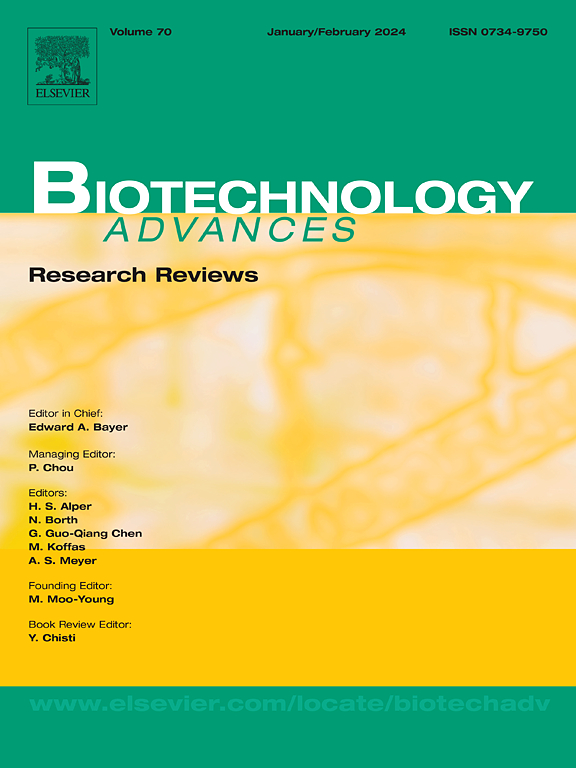Harnessing the biomolecular mechanisms of marine biomineralisation for carbon sequestration
IF 12.5
1区 工程技术
Q1 BIOTECHNOLOGY & APPLIED MICROBIOLOGY
引用次数: 0
Abstract
Anthropogenic activities, primarily fossil fuel combustion, have increased atmospheric carbon dioxide (CO2) levels and climate change effects. Carbon dioxide removal (CDR) is now widely accepted as essential in all pathways to limit global warming in line with the Paris Agreement. Biomineralisation offers compelling and promising natural pathways for durable carbon sequestration by converting CO₂ into stable carbonate minerals, a process driven by a suite of biomolecules within bio-calcifying organisms. These processes are orchestrated by biomolecules such as proteins (e.g., carbonic anhydrase, urease, bicarbonate and calcium ion transporters, templating proteins) and polysaccharides, which regulate nucleation, crystal growth, and stabilisation within specialised microenvironments. This review provides an in-depth exploration of how diverse marine bio-calcifying organisms including corals, molluscs, foraminifera, and microbial mats leverage their unique biochemistry and physiology to regulate intra/extra cellular ion concentrations and pH, thereby enabling precise control over calcium carbonate (CaCO₃) precipitation. This review highlights the intricate molecular mechanisms that underpin natural carbon biomineralisation and examines how tools from engineering biology such as engineered enzymes, photosynthetic and ureolytic microbial consortia, and cell-free systems can be leveraged to mimic and amplify these processes for enhanced carbon capture. Bridging a deep understanding of natural calcification with advanced biotechnological tools has the potential to drive the innovation and development of powerful carbon removal technologies urgently needed to reach net zero and beyond.
利用海洋生物矿化的生物分子机制进行碳封存。
人为活动,主要是化石燃料的燃烧,增加了大气中的二氧化碳(CO2)水平和气候变化的影响。根据《巴黎协定》,二氧化碳去除(CDR)现在被广泛认为是限制全球变暖的所有途径中必不可少的。生物矿化通过将二氧化碳转化为稳定的碳酸盐矿物,为持久的碳封存提供了令人信服和有前途的自然途径,这一过程由生物钙化生物体内的一套生物分子驱动。这些过程是由蛋白质(如碳酸酐酶、脲酶、碳酸氢盐和钙离子转运体、模板蛋白)和多糖等生物分子精心策划的,它们在特定的微环境中调节成核、晶体生长和稳定。这篇综述深入探讨了包括珊瑚、软体动物、有孔虫和微生物垫在内的多种海洋生物钙化生物是如何利用它们独特的生物化学和生理学来调节细胞内/细胞外离子浓度和pH值的,从而能够精确控制碳酸钙(CaCO₃)沉淀的。这篇综述强调了支撑天然碳生物矿化的复杂分子机制,并研究了如何利用工程生物学工具,如工程酶、光合作用和解尿微生物联合体以及无细胞系统来模拟和放大这些过程,以增强碳捕获。将对自然钙化的深刻理解与先进的生物技术工具相结合,有可能推动强大的碳去除技术的创新和发展,这些技术迫切需要达到净零排放甚至更高。
本文章由计算机程序翻译,如有差异,请以英文原文为准。
求助全文
约1分钟内获得全文
求助全文
来源期刊

Biotechnology advances
工程技术-生物工程与应用微生物
CiteScore
25.50
自引率
2.50%
发文量
167
审稿时长
37 days
期刊介绍:
Biotechnology Advances is a comprehensive review journal that covers all aspects of the multidisciplinary field of biotechnology. The journal focuses on biotechnology principles and their applications in various industries, agriculture, medicine, environmental concerns, and regulatory issues. It publishes authoritative articles that highlight current developments and future trends in the field of biotechnology. The journal invites submissions of manuscripts that are relevant and appropriate. It targets a wide audience, including scientists, engineers, students, instructors, researchers, practitioners, managers, governments, and other stakeholders in the field. Additionally, special issues are published based on selected presentations from recent relevant conferences in collaboration with the organizations hosting those conferences.
 求助内容:
求助内容: 应助结果提醒方式:
应助结果提醒方式:


